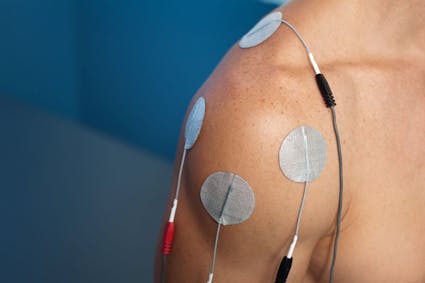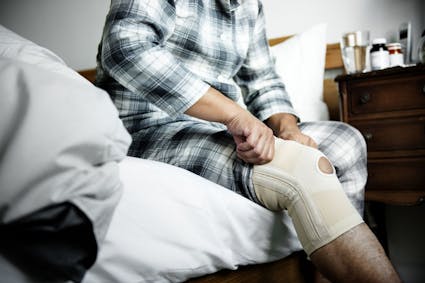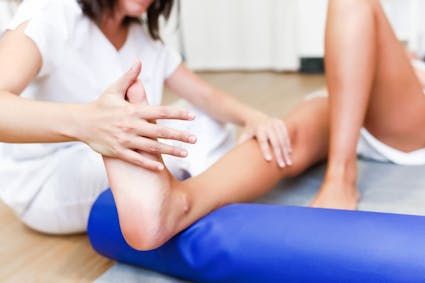Shoulder
Physical therapists (PTs) are experts in the art and science of the evaluation and treatment of human movement dysfunctions. We care for people of all ages and treat a variety of muscle, joint and neurological conditions.
Conditions we have successfully treated:
- Impingement*
- Rotator Cuff Tear
- Instability
- Fracture/Trauma
- Frozen Shoulder
- Tendinopathy
- Arthritis
What are my treatment options?
- Drugs
- Surgery
- Physical Therapy*
Advantages of Physical Therapy:
- No side effects.
- Cost-effective.
- Supported by clinical research*.
- Customized to treat the underlying cause.
Everyone is different. You may require one or two visits, or an extended care plan over several weeks or months. If you’re ready for relief, and tired of “masking” your pain, treat the cause, not just the symptoms!
* Physical therapy has been proven to be as effective as surgery. Ann Rheum Dis. 2005 May:64(5).
Knee Pain
Physical therapists (PTs) are experts in the art and science of the evaluation and treatment of human movement dysfunctions. We care for people of all ages and treat a variety of muscle, joint and neurological conditions.
Conditions we have successfully treated:
- Arthritis
- Chondromalacia
- Patellofemoral Pain
- Ligament Sprains
- Tendonitis/Bursitis
- Tendon/Muscle Strains
- IT Band Syndrome
- Post Surgical Conditions
What are my treatment options?
- Drugs
- Corticosteroid Injections
- Epidural Injections
- Physical Therapy*
Advantages of Physical Therapy:
- No side effects.
- Cost-effective.
- Supported by clinical research*.
- Customized to treat the underlying cause.
Your Recovery Process:
- Pain Relief
- Recovery of Knee Motion
- Recovery of Strength
- Functional/Sports Retraining
- Independent Home/Health Club Program
Components of Your Care:
- A thorough biomechanical evaluation.
- Extensive patient education.
- A customized treatment plan.
- Gentle hands-on techniques to relax the muscles.
- Effective joint mobilization techniques to decrease stiffness.
- Pain relieving modalities such as ice, heat, ultrasound or electrical stimulation.
- Targeted stretching for tight muscles.
- Progressive strength training.
- Balance and muscular re-education.
Everyone is different. You may require one or two visits, or an extended care plan over several weeks or months. If you’re ready for relief, and tired of “masking” your pain, treat the cause, not just the symptoms!
* Cited from the academic journal, Clinical Biomechanics, Aug. 2006.
Foot and Ankle Pain
Physical therapists (PTs) are experts in the art and science of the evaluation and treatment of human movement dysfunctions. We care for people of all ages and treat a variety of muscle, joint and neurological conditions.
Conditions we have successfully treated:
- Ankle Pain
- Shin Splints
- Ankle Sprains
- Plantar Fasciitis
- Achilles Tendonitis
- Excessive Pronation
- Post Surgical Conditions
- Tibialis Posterior Tendonitis
What are my treatment options?
- Drugs
- Corticosteroid Injections
- Surgery
- Physical Therapy*
Advantages of Physical Therapy:
- No side effects.
- Cost-effective.
- Supported by clinical research*.
- Customized to treat the underlying cause.
Your Recovery Process:
- Pain Relief
- Recovery of Mobility or Stability
- Increased Strength
- Recovery of Walking and Functional Skills
- Independent Care
Components of Your Care:
- A thorough biomechanical evaluation.
- Extensive patient education.
- A customized treatment plan.
- Gentle hands-on techniques to relax the muscles.
- Effective joint mobilization techniques to decrease stiffness.
- Pain relieving modalities such as ice, heat, ultrasound or electrical stimulation.
- Targeted stretching for tight muscles.
- Walking retraining.
- Balance exercises.
- Shoe inserts (orthotic recommendations).
* Cited from the academic journal, JBJS (American). 2006;88; Am J Sports Med 1998 May; 26(3).



